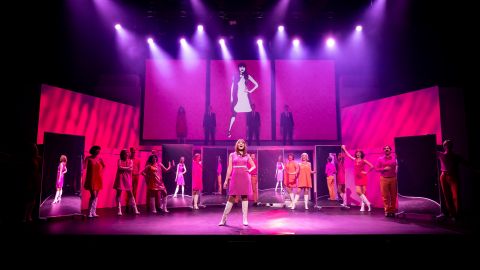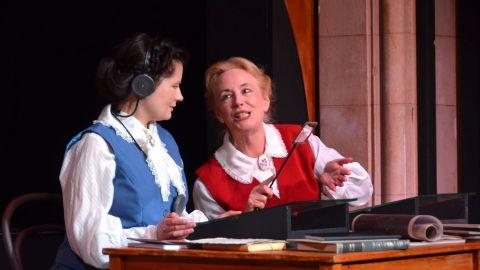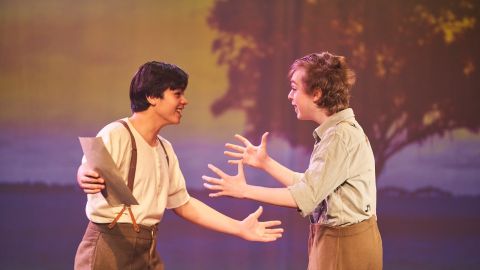Bright Star – Co-Director’s Diary

Photographer: Robert Catto
Damien Ryan from the Sport for Jove Theatre Company has stepped out of his regular Shakespearean collar and cuffs to co-direct an acclaimed musical theatre production at the Hayes Theatre in Sydney. Martin Portus interviewed him about the production.
How does co-directing work? Did you and co-director Miranda Middleton divide up the tasks mounting Bright Star? How did you reach agreement over significant artistic decisions?
Co-directing is a great experience, and one I have had several times. I think it’s underrated or there’s a perception that it is automatically a fraught situation. I can’t think of a more collaborative artform than making theatre, I always think of a director as simply being the first audience member sitting in front of the story and ‘directors’ are after all a very modern innovation – for thousands of years, writers and performers put shows together. Why should we automatically be in charge!
Collaboration should be at the heart of everything we do, so having cast, designers, dramaturgs, all working together to build a story is wonderful. Two directors is not a strange experience at all, I think, when it is among the right group of people. The only real pitfall of co-directing is contradicting each other and leaving actors confused. We never had that problem, I think.
You’re an older and more experienced director than Miranda, but she has more credits working on musicals. On Bright Star, what moments did you leave it her?
Miranda did a lot the heavy lifting (on casting). Another virtue is that we only had three weeks to rehearse so we would run two rooms at times, working a scene here while a number was worked there, doing individual notes while another beat was staged etc, filtering lots of individual conversations about performance or staging with different artists simultaneously. So it allowed for huge efficiency and we both knew where we were trying to go so it was possible to do that. It was a wonderful experience and I learned a very great deal in the process.

What appealed to you staging about Bright Star, and with Sport for Jove?
I felt the story was exactly in the wheelhouse of the very human, highly ensemble based, poetic style we try to build our work around and I loved the music itself, and a company must always keep evolving so when the opportunity arose I was quick to throw the company’s resources at it. And from there to bring in amazing people who know what they are doing in this world. It’s been a joy. Theatre is theatre and stories are stories and this one immediately touched us. We have also been asked a thousand times by people, ‘when are you going to do something at The Hayes.’ So when the cards fell, we picked up one up!
After decades bringing power and clarity to Shakespeare and other great classics, what do you admire about good musicals?
The actor-centricity of them (the best of them), is enormously appealing to me. They demand such talent and discipline, and they awe us with people’s capacity to tell a story with every fibre of their body, their instrument, their voice, their movement, their emotional range – it really is total theatre.

Isn’t it a bit unnatural that people get so happy or depressed they burst into song ….?
I don’t see a huge difference between an actor suddenly divesting themselves of their inner life through a soliloquy and an actor breaking into song, it is the same impulse and both are about rhythm, abstraction of thought, poetry and taking us on a raw journey of interiority. The other thing that impresses me so much is the discipline. The attitude of these artists who keep multiple disciplines and skill sets fresh and elite every day is bloody remarkable. That form of teamwork and individual ethic is incredible to witness.
Musicals often have lots of cliches and predictable romantic themes. But I suppose classics too have rusted-on mannerisms which need stripping away?
Yes of course, you are always trying to navigate tropisms in any story or play, some musicals probably have more of that than this little story by Steve Martin and Edie Brickell, but yes you are always just trying to get to the raw truth of things and getting behind what motivates action, even the more predictable romantic elements as you say. You need to earn them and you need to flesh them out, paint to the edges of the frame so we believe what we are seeing and hearing.
Bright Star is told to us by Alice Murphy (Hannah McInerney), it’s her Southern USA small town story of love, loss, murder and resilience. What part of it is true?
The ‘Iron Mountain baby’ is the kernel of truth in it. A child was thrown into the wilderness from a train in a valise or case in 1902. He was five days old, his name was William Moses Gould Helms, he landed in Big River in Irondale and was saved by a passing farmer and war vet, who took him home and raised him, eventually formally adopting him. Steve Martin took that story and built a world around the life of this unlikely survivor and his ‘imagined’ mother, Alcie Murphy.

The Hayes Theatre has a lovely intimacy which surely helps directors and actors find a natural, unaffected way to tell musical stories, especially community style musical like this one. Agree?
Yes, absolutely and I think this story thrives on that intimacy. I think it would also hold in a larger space and it is so full of energy and joy and human drama but the proximity is a rich experience I think.
But the stage is small and you crowd it with 16 energetic performers who act, play instruments on the move, dance and artfully repurpose stage furniture. What are the logistics in how you co-ordinate this whirlwind?
Yes, there was an enormous amount of traffic management, especially once we hit tech and all elements were in place. But that is also where this sublime cast who are like a tight knit family just worked together so patiently. Backstage and band room basically run like a Formula One pit lane.

And with Alec Steedman’s musical direction, this bluegrass music is toe-tapping from the start isn’t it?
Incredible music and incredible orchestration and musicianship yes, from a group of triple and quadruple and quintuple threats. It shouldn’t be possible to have that many skills. I now call myself a single threat – or indeed ‘no real threat’ as an artist. I can juggle! But yes, Al did a remarkable job and the blend of sounds of beautifully judged I think.
I must say with that bluegrass score, the sound balance is perfect so you hear all those instruments and lyrics clearly … and catch all of Steve Martin’s very sharp quips …
The actors are so well-cast. How did you finally choose these quadruple -threat performers? Some like Katrina Retallick are familiar faces from Sport for Jove, but most of the others?
The search was long and detailed, which is again a credit to Miranda and Alec, and to the whole philosophy of auditioning people, of which there is too little opportunity in this country so it is important to open doors as a theatre company. The demands of this show are quite particular so in some ways it was helpful to know things like, ‘Right, we need a banjo genius or a cellist or a guitarist who can act and sing and dance and ideally is a fine comedian!’ How will we find that? Because they exist, you just have to look! But yes the cast is exemplary from the super experienced national treasures like Katrina and Victoria through to the younger sublime talents in the show, it is a lovely alchemy among this troupe.

In your dreams, what musical would you most like to do next?
I get a lot of pressure to program Something Rotten, the Shakespeare musical! Naturally. We’ll see. I’d be quite keen on us doing Amelie, another human, beautiful, idiosyncratic story. Or maybe we write one…!
Who else would you like to mention on the creative team?
Shannon Burns is an incredible artist and her exceptional choreography is fundamental to the work, Isabel Hudson and Lily Mateljan’s design work created such a gorgeous, tactile atmosphere and aesthetic to work in, and James Wallis’ light alongside Jarrad Payne’s sound design complimented and extended every moment.
Bright Star is on stage at the Hayes Theatre until October 5, 2025.





